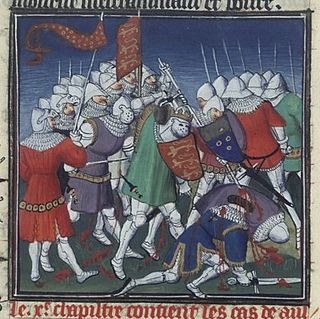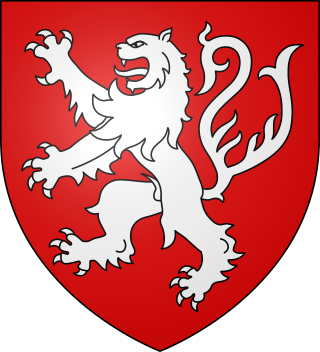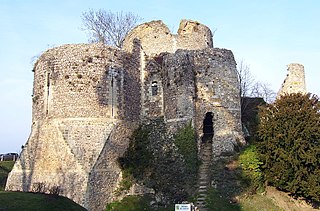Related Research Articles

The Battle of Tinchebray took place on 28 September 1106, in Tinchebray, Normandy, between an invading force led by King Henry I of England, and the Norman army of his elder brother Robert Curthose, the Duke of Normandy. Henry's knights won a decisive victory: they captured Robert, and Henry imprisoned him in England and then in Wales until Robert's death in 1134.

Emma Fitz-Osborn or Emma de Breteuil, and later Emma de Guader, was a Norman noblewoman, the wife of Ralph de Guader and the daughter of William FitzOsbern, Lord of Breteuil and later first Earl of Hereford of a new creation, who was a cousin and close adviser of William the Conqueror. William's opposition to their marriage led to the unsuccessful Revolt of the Earls.
Amaury III de Montfort was a French nobleman, the Seigneur of Montfort-l'Amaury, Épernon, and Houdan in the Île-de-France and Count of Évreux in Normandy.
Conches is the plural form of conch, a type of mollusk. It may also refer to:

Simon I of Montfort or Simon de Montfort was a French nobleman. He was born in Montfort l'Amaury, near Paris, and became its lord. He was the son of Amaury I de Montfort and Bertrade. At his death he was buried about 20 miles (32 km) away in Épernon, because it was the site of the fortress he was instrumental in constructing.

William the Conqueror had men of diverse standing and origins under his command at the Battle of Hastings in 1066. With these and other men he went on in the five succeeding years to conduct the Harrying of the North and complete the Norman conquest of England.
Raoul II de Tosny, lord of Conches-en-Ouche, was a Norman nobleman of the House of Tosny, son of Roger I of Tosny and older brother of Robert de Stafford / Tosny. He was active in Normandy, England and Wales.
Robert de Stafford was an Anglo-Norman nobleman, a member of the House of Tosny and the first feudal baron of Stafford in Staffordshire in England, where he probably built a baronial castle. His many landholdings are listed in the Domesday Book of 1086.

Roger I of Tosny or Roger of Hispania was a Norman nobleman of the House of Tosny who took part in the Reconquista of Iberia.

The House of Tosny was an important noble family in 10th and 11th century Normandy, though it did not include any comtes or vicomtes. Its founder was Raoul I of Tosny.
Raoul III of Tosny (1079-1126), Lord of Conches-en-Ouche, was an Anglo-Norman nobleman of the House of Tosny.
Lucy of Bolingbroke or Lucia Thoroldsdottir of Lincoln was an Anglo-Norman heiress in central England and, later in life, countess of Chester. Probably related to the old English earls of Mercia, she came to possess extensive lands in Lincolnshire which she passed on to her husbands and sons. She was a notable religious patron, founding or co-founding two small religious houses and endowing several with lands and churches.
Richard, Count of Évreux (c.1015–1067) was a powerful Norman nobleman during the reign of William Duke of Normandy.

St William of Breteuil or William de Breteuil was a Norman abbot and magnate who held extensive lands in central Normandy as the lord of Breteuil at the end of the reign of King William I and during the chaotic period afterwards when William's eldest son Robert Curthose, duke of Normandy, contested with his younger brother William Rufus, king of England. Upon the death of William Rufus while hunting in the New Forest, Lord William attempted—but failed—to block Prince Henry seizing the crown jewels from the Winchester treasury and declaring himself king in preference to the crusading Robert. Lord William was later abducted and tortured by a French noble who wanted to marry his illegitimate daughter Isabel. He is venerated as a saint in the Roman Catholic Church.
Simon II de Montfort was the son of Simon I de Montfort and Agnès d'Évreux.
Richard of Montfort or Richard de Montfort was a French nobleman from the House of Montfort who briefly ruled as lord of Montfort (1089–1091) in Normandy. He took the part of Count William of Évreux during his private war with Raoul II, lord of Conches. As Richard had no children at the time of his death, the lordship passed to his brother Simon II.
William of Évreux or William d'Évreux was a member of the House of Normandy who played an influential role during the Norman conquest of England, one of the few Norman aristocrats documented to have been with William I at Hastings. He was the count of Évreux in Normandy as well as additional lands and expanded his holdings by consenting to the marriage of his young ward and niece Bertrade to Fulk the Rude of Anjou, whose support against the Manceaux rebels was important for William's liege Robert Curthose. A feud between William's wife Helvise or Heloise of Nevers and Isabel of Conches, the wife of Raoul II of Tosny, led to open war between the two men. Helvise also governed Évreux in William's infirm old age until her own death. Having no children of his own, William was succeeded at Évreux by his sister's son Amaury of Montfort.
Richard of Lincoln was the illegitimate son of Henry I of England.
Robert, Count of Eu and Lord of Hastings, son of William I, Count of Eu, and his wife Lesceline. Count of Eu and Lord of Hastings.
The Council of Lillebonne was a meeting of the nobles and clergy of Normandy where, among other things, the expedition of William the Conqueror, then Duke of Normandy, was approved. It was held at Lillebonne, in the northeast of Normandy. Wace, the 12th-century historian, wrote of the council, convened shortly before the actual invasion, likely in January 1066. William of Poitiers, a chronicler of the Norman invasion, claims that the duke also obtained the consent of Pope Alexander II for the invasion, along with a papal banner.
References
- ↑ Pennington, Reina (2003). Amazons to Fighter Pilots: A Biographical Dictionary of Military Women. Westport, Connecticut: Greenwood Press. p. 541. ISBN 0-313-29197-7.
- ↑ Edgington, Susan, and Sarah Lambert, Gendering the Crusades, Columbia University Press, 2002, pp. 53- 54. ISBN 978-0-231-12598-7
- ↑ Châtelain 1983, p. 86.
- 1 2 Mason 1979, p. 125.
- ↑ Murray 2000, p. 31.
- ↑ Johns, Susan M., Noblewomen, aristocracy and power in the twelfth-century Anglo-Norman realm
- ↑ Hicks, Leonie V., A Short History of the Normans
- ↑ Barlow 1983, p. 286.
Bibliography
- Barlow, Frank (1983). William Rufus. Berkeley: University of California Press.
- Châtelain, André (1983). Châteaux forts et féodalité en Ile de France, du XIème au XIIIème siècle (in French). Nonette.
- Johns, Susan M. Noblewomen, aristocracy and power in the twelfth-century Anglo-Norman realm. Manchester University Press, 2003, p. 14.
- Mason, Emma (1979). "Magnates, curiales, and the Wheel of Fortune". In Brown, Reginald Allen (ed.). Proceedings of the Battle Conference on Anglo-Norman Studies: 1979. Vol. II. The Boydell Press.
- Murray, Alan V. (2000). The Crusader Kingdom of Jerusalem: A Dynastic History, 1099–1125. Prosopographica et Geneologica. ISBN 978-1-9009-3403-9.